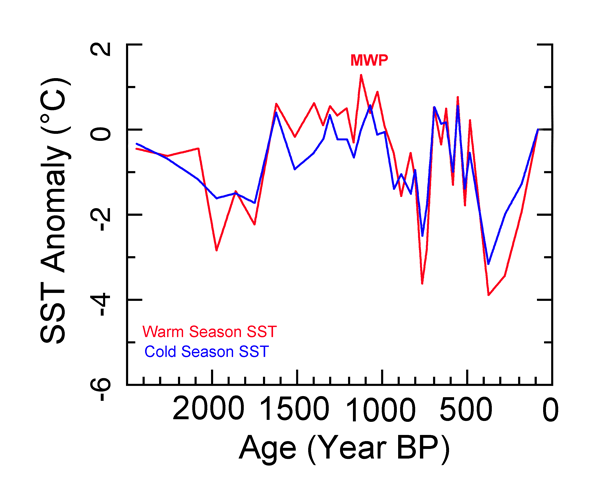Reference
deMenocal, P., Ortiz, J., Guilderson, T. and Sarnthein, M. 2000. Coherent high- and low-latitude climate variability during the Holocene warm period. Science 288: 2198-2202.
Description
Working with the vertical sediment profile of Ocean Drilling Program Hole 658C -- which was cored off Cap Blanc, Mauritania (20°45'N, 18°35'W) at a water depth of 2,263 meters -- the authors analyzed various parameters, including planktonic foraminiferal assemblage census counts, from which they calculated warm- and cold-season sea surface temperatures, based on transfer functions derived from faunal analyses of 191 other Atlantic core tops. This work revealed that between about AD 800 and 1050 the "Medieval Warm Period," as they describe it, "was only marginally warmer than present," which from the graphical presentation of their results amounts to be between 0.6 and 1.2°C for the cold and warm season SST estimates, respectively (see figure below).
However, there is some uncertainty with respect to what year corresponds with the authors definition of the present. The SST graphic reproduced below from their paper, for example, indicates that the "present" corresponds to around the year 1900, whereas the text of their paper indicates the first data point represents conditions from between a sediment depth of 0 and 2 cm, and that the core "was continuously subsampled at 2-cm intervals, which is equivalent to between 50 and 100 years temporal resolution." Because of this ambiguity, we have decided to classify this paper as a Level 2 study where, erring on the side of caution, we conclude the MWP warmth was about the same as the warmth of the past two to three decades, which qualitative assessment we arrive at by noting that the surface air temperature of the globe has warmed by about 0.7 °C over the past 100 years, which value falls between the 0.6 and 1.2°C sea surface temperature differential between the peak warmth of the MWP and that of deMenocal et al.'s "present."

West African sea surface temperature vs. time. Adapted from de Menocal et al. (2000).




